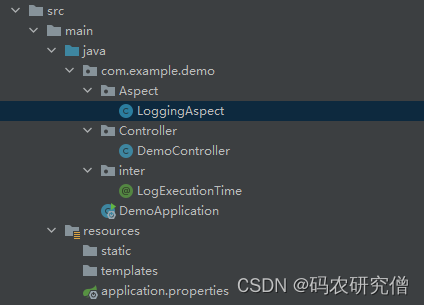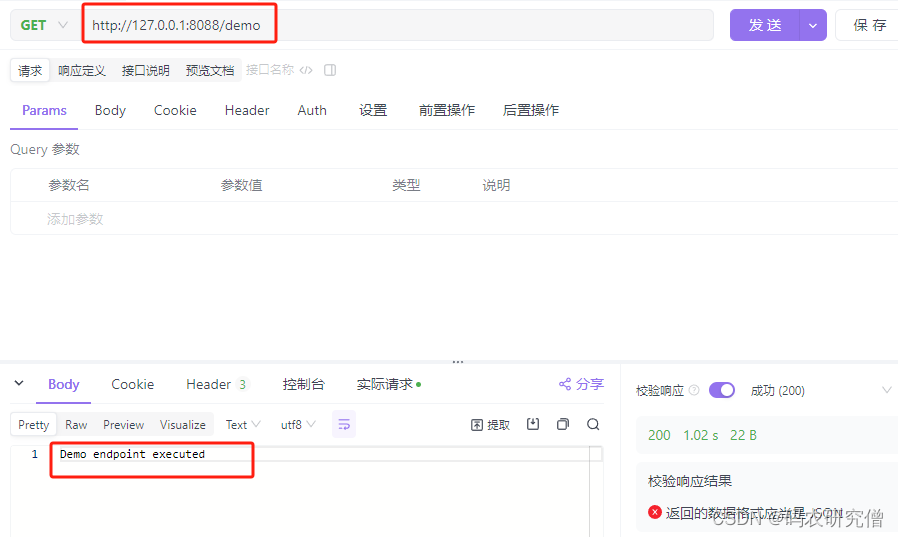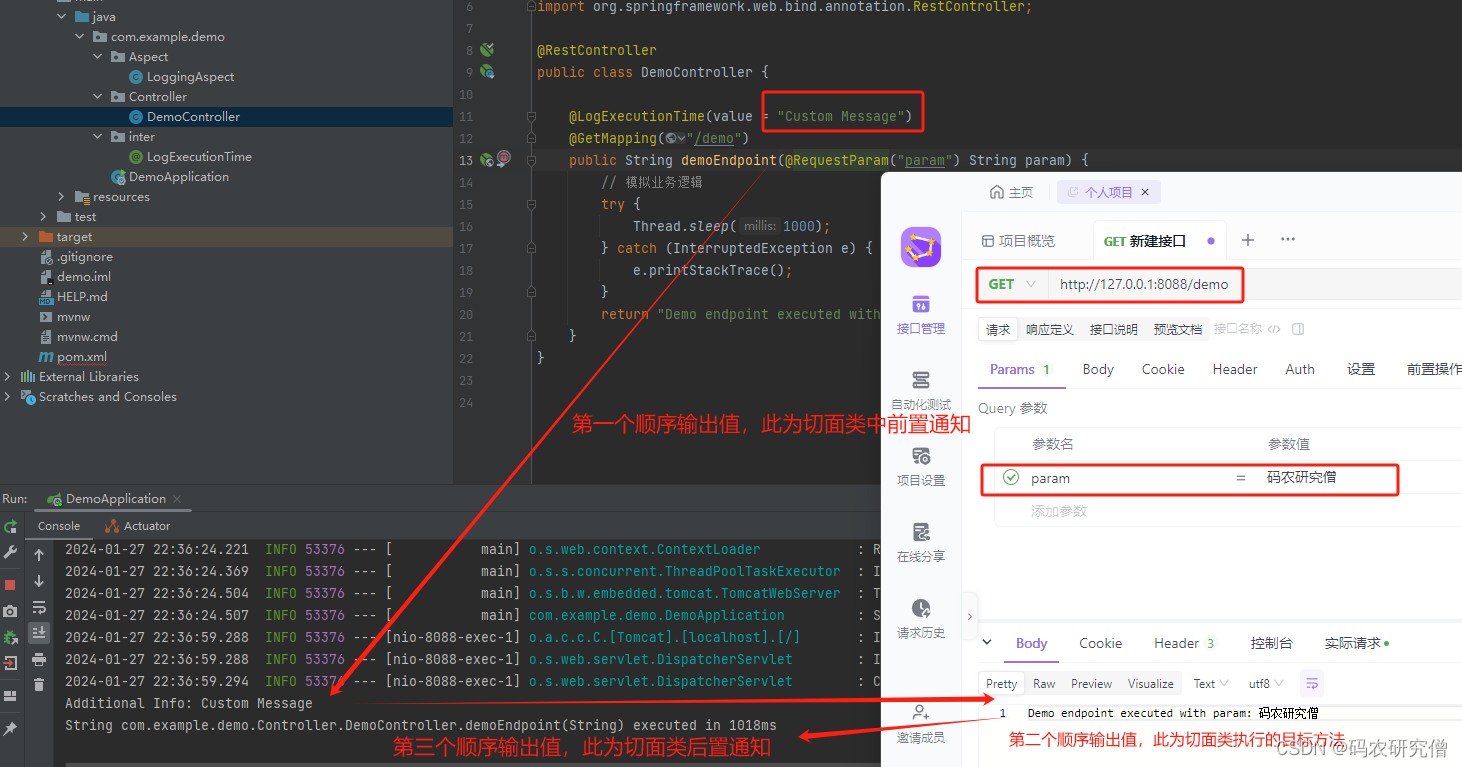- 漫途水产养殖水质智能监测方案,科技助力养殖业高效生产!
- 抓包工具:Sunny网络中间件
- Idea搭建springboot基本框架
- 如何下载IDEA2023.3.4 最新激活破解教程
- 【手写数据库toadb】toadb表对象访问操作,存储管理抽象层软件架
- Hive:开窗函数
- 网络编程套接字(1)—网络编程基础
- 前馈神经网络解密:深入理解人工智能的基石
- Rust面试宝典第7题:单词接龙
- vue-create 创建 VUE3项目-创建
- 全网最最最最详细如何卸载centos7中安装的nginx的教程~
- 「PHP系列」PHP 多维数组详解
- Mysql中的Optimize table命令
- 避免 MySQL 插入重复数据的 4 种方式
- MySQL高可用解决方案――从主从复制到InnoDB Cluster架
- Linux部署环境Nginx篇(安装Nginx1.24.0)
- Rust 基本环境安装
- IntelliJ IDEA 2023.3 的 AI Assistant
- Mac电脑如何安装Python环境
- MySql 安装,小白也可以学会成功安装的保姆级教程
- 在 PostgreSQL 中,查看表是否被锁住以及解锁语句
- 如何利用SpringSecurity进行认证与授权
- 【Rust】——项目实例:——命令行实例(一)
- 计算机体系架构
- MySQL 故障诊断:MySQL 占用 CPU 过高问题定位及优化
- Flink实战之 MySQL CDC
- Springboot数据加密篇
- 一篇文章掌握SpringCloud与SpringCloud Aliba
- 【精·超简单】SpringBoot 配置多个数据源(连接多个数据库)
- Springboot使用数据库连接池druid
目录
- 前言
- 1. 基本知识
- 2. Demo
- 2.1 不带参数
- 2.2 带参数
前言
此知识点都来源于项目实战,对此进行科普总结,使得之后项目游刃有余
对于Spring的基本知识,推荐阅读:
- Spring框架从入门到学精(全)
- java框架 零基础从入门到精通的学习路线 附开源项目面经等(超全)
1. 基本知识
在Java中,@Around注解通常与AspectJ框架一起使用,用于定义一个环绕通知(around advice)。
- AspectJ是一个面向切面编程的框架,它允许开发者通过切面(aspects)来模块化横切关注点。
- 环绕通知是AspectJ中的一种通知类型,用于在目标方法执行前后完全控制目标方法的执行。
此处着重加深一下环绕通知以及切面这两个抽象名词的概念,有助于加深@Around注解
👇👇👇
环绕通知(Around Advice)概念:
-
定义:
切面中的一种通知类型,它允许在目标方法执行前后完全控制目标方法的执行。
可以决定是否继续执行目标方法,以及是否修改目标方法的输入参数和返回值。
-
特点:
最灵活的通知类型,提供了对目标方法的完全控制。它能够在目标方法执行前后执行自定义逻辑,包括修改方法的输入和输出。
-
执行步骤:
1.在目标方法执行之前,环绕通知执行前置逻辑。
2.调用ProceedingJoinPoint.proceed()来执行目标方法。
3.在目标方法执行之后,环绕通知执行后置逻辑。
-
使用场景:
记录方法执行时间
权限验证
缓存控制
事务管理等
👇👇👇
切面(Aspect)概念:
-
定义:
切面是一种模块化的方式,用于将横切关注点(cross-cutting concerns)从业务逻辑中分离出来
横切关注点包括日志记录、性能统计、安全性等,它们通常涉及多个对象和方法
-
主要组成:
1.切入点(Join Point): 在应用程序执行期间的某个特定点,如方法调用、异常抛出等。
2.通知(Advice): 定义在切入点上执行的操作,包括前置、后置、环绕、异常等不同类型的通知。
3.切入点表达式(Pointcut): 用于匹配切入点的表达式,决定在哪些切入点上执行通知。
-
主要作用:
将横切关注点集中管理,避免散布在各处的重复代码
提高代码的模块化和可维护性
2. Demo
以下两种Demo示例大同小异
其中不带参数与带参数章节,差异在于切面类是否可以携带参数(大白话:自定义的注解中是否携带参数,增强处理类就是否有参数)
导入依赖:使用@Around注解,先导入AspectJ库
org.aspectj aspectjrt 1.9.7 2.1 不带参数
- 创建自定义注解:创建一个自定义的注解@LogExecutionTime,该注解用于标记需要记录执行时间的方法
import java.lang.annotation.ElementType; import java.lang.annotation.Retention; import java.lang.annotation.RetentionPolicy; import java.lang.annotation.Target; @Target(ElementType.METHOD) @Retention(RetentionPolicy.RUNTIME) public @interface LogExecutionTime { }- 创建切面类:创建一个切面类LoggingAspect,其中包含一个使用@Around注解的环绕通知
import org.aspectj.lang.ProceedingJoinPoint; import org.aspectj.lang.annotation.Around; import org.aspectj.lang.annotation.Aspect; import org.springframework.stereotype.Component; @Aspect @Component public class LoggingAspect { // @Around("@annotation(com.example.demo.LogExecutionTime)")表示该环绕通知仅在使用@LogExecutionTime注解的方法上执行 @Around("@annotation(com.example.demo.LogExecutionTime)") public Object logExecutionTime(ProceedingJoinPoint joinPoint) throws Throwable { long startTime = System.currentTimeMillis(); // 执行目标方法 Object result = joinPoint.proceed(); long endTime = System.currentTimeMillis(); System.out.println( joinPoint.getSignature() + " executed in " + (endTime - startTime) + "ms"); return result; } }- 创建控制器类:创建一个简单的Spring Boot控制器类,其中包含一个被@LogExecutionTime注解标记的方法
import org.springframework.web.bind.annotation.GetMapping; import org.springframework.web.bind.annotation.RestController; @RestController public class DemoController { @LogExecutionTime @GetMapping("/demo") public String demoEndpoint() { // 模拟业务逻辑 try { Thread.sleep(1000); } catch (InterruptedException e) { e.printStackTrace(); } return "Demo endpoint executed"; } }- 启动应用程序:创建一个Spring Boot应用程序入口类,启动Spring Boot应用
import org.springframework.boot.SpringApplication; import org.springframework.boot.autoconfigure.SpringBootApplication; @SpringBootApplication public class DemoApplication { public static void main(String[] args) { SpringApplication.run(DemoApplication.class, args); } }- 访问端点:启动应用程序后,访问http://localhost:8080/demo,可在控制台中可以看到输出的执行时间信息
(由于代码模块中8080已被占用,此处在配置文件中修改为8088端口,并且使用测试接口测试)
# application.properties 文件 server.port=8088
以上是测试模块的代码,为了书写规整,博主将其归类如下,大致也差不多

输出截图如下:
结果先出这个,这个是执行过程输出!

最后是环绕后置通知:

通过切面和环绕通知,实现在不修改业务逻辑的情况下,记录方法执行时间的功能。
切面提供了一种清晰、模块化的方式来处理横切关注点
2.2 带参数
- 带参数自定义注解:(这个注解带有一个value参数,用于传递额外的信息)
import java.lang.annotation.ElementType; import java.lang.annotation.Retention; import java.lang.annotation.RetentionPolicy; import java.lang.annotation.Target; @Target(ElementType.METHOD) @Retention(RetentionPolicy.RUNTIME) public @interface LogExecutionTime { String value() default ""; }- 切面类:
在@Around注解中使用@annotation(logExecutionTime)表示将注解信息传递给切面方法。
通过LogExecutionTime logExecutionTime参数获取注解的值,然后在切面逻辑中使用
import org.aspectj.lang.ProceedingJoinPoint; import org.aspectj.lang.annotation.Around; import org.aspectj.lang.annotation.Aspect; import org.springframework.stereotype.Component; @Aspect @Component public class LoggingAspect { @Around("@annotation(logExecutionTime)") public Object logExecutionTime(ProceedingJoinPoint joinPoint, LogExecutionTime logExecutionTime) throws Throwable { long startTime = System.currentTimeMillis(); // 打印传入的参数值 String additionalInfo = logExecutionTime.value(); System.out.println("Additional Info: " + additionalInfo); // 执行目标方法 Object result = joinPoint.proceed(); long endTime = System.currentTimeMillis(); System.out.println( joinPoint.getSignature() + " executed in " + (endTime - startTime) + "ms"); return result; } }- 控制类:
在控制器类中,@LogExecutionTime(value = "Custom Message")注解传递一个带参数的自定义消息
在demoEndpoint方法中,也接收了一个@RequestParam参数,用于演示带参数的情况。
(对于@RequestParam参数,推荐阅读:
1.详细分析Java中的@RequestParam和@RequestBody
2.@pathvariable 和 @Requestparam的详细区别)
这样,通过@Around注解和ProceedingJoinPoint,能够实现对带参数的自定义注解进行更灵活的处理。
import org.springframework.web.bind.annotation.GetMapping; import org.springframework.web.bind.annotation.RequestParam; import org.springframework.web.bind.annotation.RestController; @RestController public class DemoController { @LogExecutionTime(value = "Custom Message") @GetMapping("/demo") public String demoEndpoint(@RequestParam("param") String param) { // 模拟业务逻辑 try { Thread.sleep(1000); } catch (InterruptedException e) { e.printStackTrace(); } return "Demo endpoint executed with param: " + param; } }截图如下:

-














